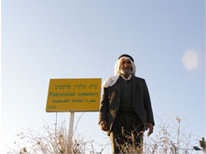On Friday, December 28, 2007 we held a tour of the Palestinian village al-Malha in Jerusalem. A large part of the village with its houses and alleys -- but without it's Palestinian residents -- still stands in the heart of the Malha neighborhood in Western Jerusalem.
About 100 people took part in the tour, some of them refugees of al-Malha, who came from neighboring Sharfat, the village they moved to after the expulsion in July 1948. The refugees told us about life in the village before the occupation and we learned about the fighting that took place in the area in the war of 1948.
We passed through the alleys of the village and the refugees designated the names of owners of still existing houses. We overlooked the area standing on the "al-Ras" hilltop, near the mosque and the cemetery. Before 1948 the villagers overlooked their olive groves and flock from here. Today, in addition to the houses of the new Jewish neighbohood, "Teddy" soccer stadium, Malha shopping-mall, the Technologic Campus and other new buildings are seen from here.
We posted a sign marking the Palestinian cemetery, next to "Ort-Minkoff" high-school. Another sign, bearing the inscription "Al-Malha village - 1948", was posted at the entrance of the village in the beginning of the tour. Someone made sure it would be extracted before the tour came to an end.
We handed out the booklet "Remembering Al-Malha" which was produced for the event. It is the 23rd booklet in a series of booklets produced by Zochrot, commemorating the villages and towns existing before the Nakba.
The tour was planned in collaboration with UYAC (Union of Youth Activity Centers - Palestine Refugee Camps), headed by Wajih Atallah, of Qalandia refugee camp, and supported by HEKS/EPER.
Many of the children and grandchildren of the refugees who came to the tour of their village, al-Maliha, were there for the first time in their lives. Some of the younger people were moved by the beauty of the houses and the alleyways and said enthusiastically that they were similar to the houses in "Bab al-Hara," the Syrian television series that fascinated viewers in the Arab world three months ago. The series takes place in a Damascus neighborhood in the 19th century. The houses of al-Maliha were reminiscent of the beautiful traditional Syrian houses that appeared on the television screens of refugees from al-Maliha.
Our tour brought the second and third generations back to their village and moved them greatly. For the first time, even though they live today in Sharafat (near Beit Safafa), a distance of a mere 2-3 kilometers from al-Maliha. In contrast, most refugees of the village live today beyond military checkpoints in Ramallah, Bethlehem and Beit Jallah, or beyond the border in Jordan.
The tour was very emotional. It was especially painful and enraging because it brings you in practice into a real, whole neighborhood that exists today as it existed then. The refugees recounted the names of the owners of almost all the houses. Every house has an owner and every owner has a name. These are moments that make you shiver. There were moments when I felt as if I were inside a computer game or a 3D simulator. The houses, the alleys, the architecture, the windows, the arches, the mosque — everything was as it was before the occupation, but the residents were foreign. A strange foreignness. The first local resident we spoke to lives in a house that bears an Arabic inscription noting the date the house was built — 1935 — above the entryway. She spoke to us in Hebrew. She said she came from Syria and had lived in the house for 17 years. She had married the son of the 'owner' of the property and continues to live in her in-laws' house. This is similar to what happens in Syria in reality, as portrayed in one of the scenes of the Syrian series 'Bab al-Hara.' The woman claimed that she knew the history of the place, and when the cameras that accompanied us turned to film her, she covered her face and went back inside. An old Jewish man said that he had come from Iraq and had lived in the neighborhood since 1951. Others came from Tunisia. In this case both the occupier and the occupied speak a language that is the same, but different.
The mosque is also virtually the same, but instead of Muslims praying Jews reside there. One of the residents of the neighborhood yelled and pushed at us. It was to be expected. Even less than expected. It shows that we can dare to speak. The world will not crumble.
The Palestinian cemetery has mostly vanished. A few tombstones still stand. A Jewish school, Minkoff Ort, is situated right beside it, almost touching those tombstones. The wall facing the cemetery is windowless. Thus tolerance is taught in the school. The wall is opaque, there is no way we could have seen.
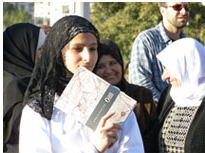
Al-Maliha Tour 2007
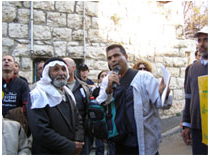
Al-Maliha Tour 2007 (3)
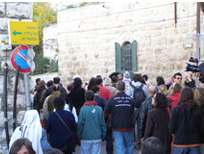
Al-Maliha Tour 2007 (4)
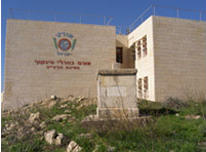
Al-Maliha Tour 2007 (2)



